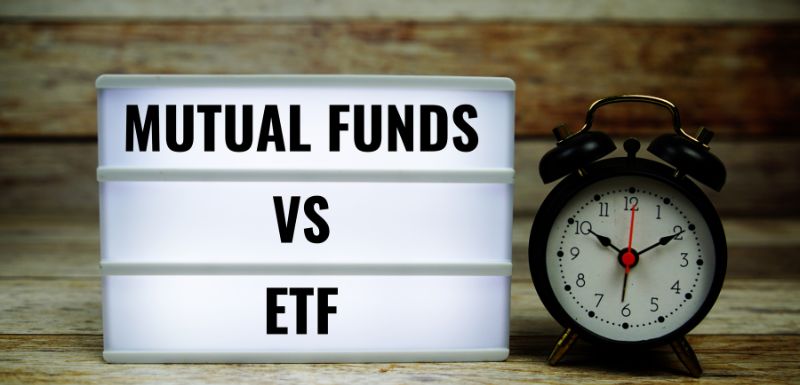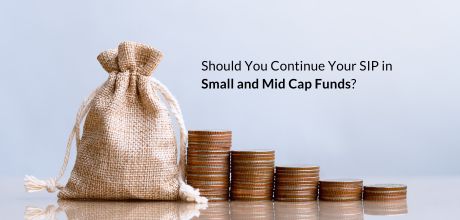ETF vs Actively Managed Mutual Funds: Key Differences Every Investor Should Know

When investing in mutual funds, investors can choose from schemes that can give market returns (benchmark index) or have the potential to outperform the market. Passive schemes, including index funds and exchange-traded funds (ETFs), provide returns that mirror the benchmark. Active schemes have the potential to outperform the benchmark. Many investors wonder whether to choose ETF or mutual fund. In this article, we will understand what are mutual funds and ETFs, their differences, and which is better: ETF or mutual fund.
What Are ETFs and Mutual Funds?
Let us start by understanding what are ETFs and mutual funds.
What Are ETFs?
An exchange-traded fund (ETF) tracks or mirrors the performance of a benchmark index. It invests in all the benchmark index constituents as per their weightage in the index. The returns are similar to that of the benchmark index. The objective is to mirror the performance of the benchmark index and not outperform it.
For example, a Nifty 50 ETF invests in all the 50 constituents of the Nifty 50 Index as per their weightage in the Nifty 50 Index. Its objective is to track and mirror the performance of the Nifty 50 Index.
The units of an ETF are listed on a stock exchange like the NSE. The buying and selling of units happen through the stock exchange. An investor can buy the ETF units by logging into their trading account. The money is debited from the investor’s trading/bank account, and ETF units are credited to the demat account.
In India, ETFs are offered on:
- Broad market capitalisation indices like Nifty 50, Nifty Next 50, Nifty Midcap 150, Nifty Smallcap 250, etc.
- Sectoral indices like Nifty Bank, Nifty India Consumption, Nifty Realty, Nifty Healthcare, etc.
- Commodities like gold, silver, etc.
- Various debt indices
- Smart beta indices based on factors like momentum, quality, alpha, value, low volatility, etc.
What Are Active Mutual Funds?
As the name suggests, an active mutual fund is actively managed by the fund manager. The fund manager decides which company shares to buy, the quantity, the price, etc. Similarly, the fund manager takes the sell decision. The objective is to outperform the benchmark index. For example, a large-cap active fund with the Nifty 50 as the benchmark will aim to outperform the Nifty 50 Index.
You don’t need a demat account to purchase the units of an active mutual fund. The units can be bought and redeemed through the fund house anytime. Active mutual fund units can be accumulated for long-term financial goals through the systematic investment plan (SIP) route. You can invest a specified amount every month in a disciplined manner. With step-up SIP, you can increase the monthly investment amount by an absolute amount or percentage of the base SIP amount every year.
Now that we understand the basics of both products let us look at the difference between ETF and mutual funds.
ETF vs Mutual Fund: What’s the Difference?
AMCs offer ETFs and active mutual funds. However, they have differences. Let us look at how are ETFs different from mutual funds.
ETF Versus Mutual Fund
|
ETFs |
Active mutual funds |
|
An investor has to buy ETF units by logging into their trading account and placing purchase orders on the stock exchange. |
An investor has to buy active mutual fund units from the AMC either directly or through an intermediary like a mutual fund distributor (MFD) or third-party online platforms. |
|
The investor has to incur charges like brokerage, demat account opening and AMC charges, depository charges, etc. |
The investor doesn’t need to incur any of these charges involved in buying/selling ETFs. |
|
The units may be bought and sold either at NAV, premium to NAV or discount to NAV. |
The units are always purchased and redeemed at NAV. |
|
As the units are bought and sold through a stock exchange, liquidity can sometimes be an issue. |
As the units are bought and redeemed through the AMC, liquidity is never an issue. |
|
A fixed number of units are issued and listed on the stock exchange. Post listing, the number of ETF units remains constant. |
For every purchase order, the AMC issues new units. For every redemption request, the AMC extinguishes the redeemed units. Hence, the number of units keeps changing almost every market trading day. |
|
The scheme returns are similar to the benchmark index returns (after adjusting for expense ratio and tracking error). |
The scheme returns can be similar, higher, or lower than the benchmark index returns. |
|
There is no exit load on selling ETF units. |
If the active fund units are redeemed before a specified minimum holding period, an exit load is charged. |
|
ETF units can be bought and sold during market trading hours. |
Active mutual fund units can be purchased and redeemed with the AMC anytime. |
Now that you understand the differences, the next question that will come to mind is: ETF vs mutual fund: Which is better?
ETF or Mutual Fund: Which Should You Choose?
The choice between ETF and mutual funds depends on various factors. Some of these include the following.
1) Liquidity
In the case of some ETFs, as they are exchange-listed, liquidity can be an issue. If there are not enough sellers, you may not be able to buy the desired quantity of units or may have to buy units at a higher price than the NAV. Similarly, if there are not enough buyers, you may not be able to sell the desired quantity of units or may have to sell at a lower price than NAV.
However, in the case of active mutual funds, liquidity is never an issue. You can purchase or redeem any quantity of units at the NAV at any time with the AMC.
2) SIP Availability
Most people earn a regular monthly income and prefer to invest a regular monthly amount towards their financial goals. Also, as their annual income grows, they prefer to increase the monthly investment amount every year. A systematic investment plan (SIP) offers these features. However, the SIP option is available with active mutual funds and not with ETFs.
SIPs are an excellent tool to invest regularly towards your financial goals. It makes you a disciplined investor for the long term. With a longer investment horizon, your money gets time to grow and benefit from the power of compounding and create wealth for you. Hence, with the liquidity and SIP feature, active mutual funds hold an edge over ETFs.
FAQs
How Does the Expense Ratio of ETFs and Active Mutual Funds Compare?
As no active management is involved, the expense ratio of ETFs is usually lower than active mutual funds.
The fund manager, backed by a research team, takes the buy/sell decisions and actively manages the scheme. Hence, the expense ratio is usually higher than in ETFs.
What Is the Minimum Purchase for ETFs and Active Mutual Funds?
In an ETF, the minimum purchase is one unit, and the minimum investment amount is the price of one unit. No fractional units can be bought.
In active mutual funds, the minimum purchase amount may vary across mutual fund houses. It usually starts from Rs. 100. Fractional units can be bought based on the purchase amount.
Your Investing Experts
Relevant Articles
How To Select The Best Mutual Funds For Long Term Goals
Mutual funds offer a compelling way to invest for long-term goals, leveraging professional management and diversification to potentially achieve significant returns. But with a vast array of options available, selecting the best mutual funds for the long term can feel daunting. This guide will equip you with the knowledge to confidently navigate the mutual fund landscape and learn how to select the best mutual fund aligned with your long-term aspirations.
Should You Continue Your SIP in Small Cap Mutual Funds
Investing in small cap funds requires patience and discipline, especially during market corrections. By staying committed to your SIPs and focusing on long-term goals, you can leverage the power of rupee cost averaging and compounding. Don’t let short-term market noise dictate your strategy—remain focused, stay the course, and trust that your disciplined approach will yield results over time.
Systematic Withdrawal Plans (SWP): A Reliable Way to Generate Regular Income
An SWP allows investors to withdraw a predetermined amount from their mutual fund investments at regular intervals, such as monthly, quarterly or annually. The beauty of SWPs lies in their flexibility—they provide consistent income while allowing the remaining investment to continue growing.
.png)


_(2).jpg)